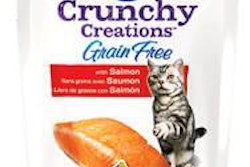The feeding of raw petfood has been a controversy for decades. Both sides of the discussion have their extremist factions, with some believing it is the ultimately healthful means of feeding dogs and cats and others convinced it constitutes a wholly unwarranted risk to the health of both pets and the people feeding them. Two recently released documents add ammunition to the anti-raw argument, though it is unlikely that the staunch supporters of raw petfood will be swayed from its use by this new information.
I have broached the subject of raw petfood in this column on several occasions over the years. However, few people are aware that in the 1970s, I was directly responsible for developing, making and feeding a group of dogs a diet consisting of raw dressed chicken carcasses (i.e., with whole bone), raw hamburger, apples and a few other ingredients as part of my undergraduate research study. As a pre-vet student, I was certain these dogs' intestinal tracts would become impacted with bones within weeks, but that never happened.
I was no longer at that institution at the termination of the study, but as far as I know, the dogs on the raw food remained healthy throughout the two-year trial. Regardless, and in keeping with the usual theme of my column, my focus in this matter is not whether I personally think raw petfood is safe and suitable, but rather to offer my thoughts as to the regulatory implications for commercial manufacturers.
The American Veterinary Medical Association (AVMA) received a plethora of angry responses to its issuance of a policy statement essentially condemning the practice of feeding raw petfoods a few years back. Unrelated to that policy, the December 1, 2013 issue of the Journal of the AVMA contains a review article looking at both the risks and benefits of raw feeding (see link).
Some positive effects were noted, though frankly, much of the purported benefits were not found to be supported by sufficient scientific study. Regarding risks, the paper considered potential nutritional deficiencies as well as the prevalence of microorganism contamination. These risks should be mitigated, though not wholly eliminated, when feeding commercial products compared to home-prepared raw formulations, though the authors warn that the degree of compliance with applicable regulations may vary between raw petfood manufacturers (the same is true for processed petfoods!). The paper concludes with recommendations for veterinary practitioners to help counsel clients on the subject.
In November of 2013, the Center for Veterinary Medicine in the US Food and Drug Administration (FDA) released the results of its surveillance study on the incidence of contamination with pathogenic bacteria in both raw and processed petfoods (including dry and semi-moist dog and cat foods, jerky treats, and dry specialty petfoods) (see link). Of the 196 raw products tested, 15 (7.6%) tested positive for Salmonella while 32 (16.3%) tested positive for Listeria monocytogenes. In comparison, only one of the 860 processed petfood samples were found to contain Salmonella (0.001%) and none contained Listeria.
Some have questioned the veracity of these reported results considering the incidence of Salmonella-related recalls in processed petfoods over the past few years. Regardless, these findings for raw foods should not be surprising considering the prevalence of contamination of raw meat and poultry intended for human consumption.
For example, under the regulations of the Food Safety and Inspection Service of the US Department of Agriculture (USDA), the performance standard for raw ground turkey for presence of Salmonella is 49.9% [9 CFR 381.94]. In other words, for that type of raw product it requires at least half of the samples to be positive before enforcement action is taken. While USDA continuously strives to implement measures to reduce the incidence of contamination, it recognizes that total elimination of pathogens in raw products is infeasible.
On the other hand, FDA has a zero-tolerance policy regarding Salmonella in petfoods, raw or not. Some have questioned whether that's fair to raw petfood manufacturers. After all, a person intent on feeding raw can purchase meat or poultry at the grocery store and run a potentially greater risk of exposing his/her dog or cat to contamination than if a commercial petfood was purchased. Besides, reportedly dogs and cats are relatively tolerant of (although far from immune to) food-borne illness from pathogenic organisms like Salmonella, anyway. So, why not grant the raw manufacturers some slack in this matter?
The distinction between USDA and FDA is that labeling for raw meat and poultry sold for human consumption must bear adequate warning statements, including explicit instructions to cook the product in a manner sufficient to destroy pathogenic organisms. While it is unlikely that all consumers will follow these instructions, from USDA's viewpoint at least there is an effort to make them aware of the potential risks.
For raw petfoods, though, any cooking would defeat the whole purpose of feeding it in the first place. So, from FDA's perspective, there is no basis to allow any deviation from its policy for petfoods in general. This also would be consistent with USDA regulations for "ready-to-eat" meat and poultry products, where products not processed in a manner to render them free of contamination with Salmonella would be deemed to be adulterated and subject to recall (9 CFR 318.17 and 381.150).
Notwithstanding either of these reports, the practice of raw feeding is likely to remain popular in some circles; hence, a niche for commercial companies will be there for some time. While a definite challenge, it is in the best interest of the manufacturer of raw petfoods to strive to minimize the potential risks by whatever means possible. This includes stringent processing standards, prominent instructions to the purchaser as to proper handling, full compliance with all labeling and nutritional standards required of any petfood, and diligent and thorough response to any recall situation.
Because procurement of "human-grade" meat and poultry for use in raw petfood does not guarantee the lack of contamination with pathogens, the implementation of non-thermal kill steps as part of the manufacturing process appears very prudent.


















